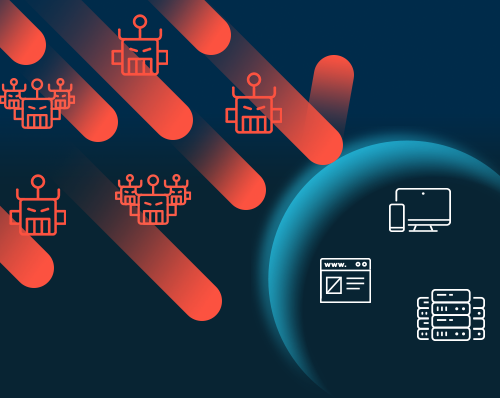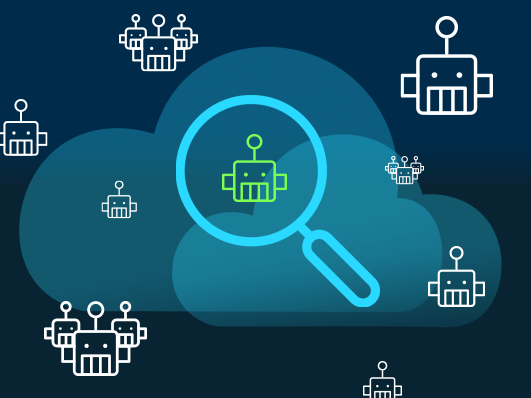New: Flexible service plans for Myra WAF. Learn more!
Home>
Bot Management
At one look
- 01. A Definition of What Bot Management Is
- 02. How Does a Bot Management Solution Work?
- 03. What Are the Benefits of a Bot Manager?
- 04. How Does Bot Protection Contribute to IT Security?
- 05. What Attacks Does Bot Management Protect Against?
- 06. How Can Companies Use Bot Management?
- 07. What You Need to Know About Bot Management
01
A Definition of What Bot Management Is
A bot (short for "robot") is a computer program that performs predefined, usually repetitive tasks automatically and autonomously - i.e. without human intervention. Bots are used, for example, to index the internet for search engines, to provide certain information on social media or to answer customer inquiries via email or chat. In addition to such beneficial bots, there are also malicious bots that cyber criminals use for automated attacks such as overload attacks, phishing and account takeover. Bad bots are often part of a botnet consisting of interconnected internet-enabled devices such as IP cameras, network printers or smart TVs and are controlled via central command and control servers (C&C or C2 servers).
A bot manager allows effective control of all bot activities - from detection to prevention and response. Various techniques (fingerprinting, behavioral analysis, IP blocklisting, rate limiting, etc.) are combined in a single solution and ideally supplemented by manual analyses by security experts from a Security Operations Center (SOC). A properly set up bot management system identifies trustworthy bots by recognizing the bot reputation, evaluating the original IP addresses and observing the behavior of bots. Trustworthy bots are added to an allowlist and can continue to access the website, while untrustworthy and malicious bots are denied access.
02
How Does a Bot Management Solution Work?
A bot management solution enables the detection and targeted handling of bots. Distinguishing malicious bot requests from harmless requests from beneficial bots or human users is one of the biggest challenges in bot management. Bad bots access websites with different IP addresses and from different networks. The automated programs pretend to be a normal browser and spoof other information such as Autonomous System Number (ASN) or device ID to give the appearance of regular use. A bot manager combines the following measures to enable clear identification:
Behavior Analysis / Pattern Recognition
Continuous monitoring of user behavior helps to detect unusual activities or access patterns that deviate from standard user behavior (e.g. page views or input speed) and thus indicate bot activity. This pattern recognition is automated using algorithms to identify characteristic behaviors of bots. As a result, deep bot protection can not only distinguish humans from bots, but also trustworthy bots from malicious ones.
IP Address Monitoring
The monitoring of IP addresses using bot protection enables the detection of suspicious activities originating from a single IP address or a specific IP address range. This includes frequently repeating requests or unusually high data traffic from one source. IP blocklisting allows you to discard such suspicious requests, as well as requests from known malicious source IP addresses or address ranges, before they can affect the website or network. However, advanced bots can spoof their IP address or use other obfuscation tactics to bypass blocklists. IP blocklisting is therefore only one of several defensive measures of a bot management solution.
CAPTCHAs
The use of CAPTCHAs and other human interaction challenges can also help to differentiate between human and bot-type behavior. The small image or word puzzles are easy for humans to master, but cause problems for computers. Such CAPTCHA checks are used to secure online forms, for example, but also to avoid false positives, i.e. requests that are incorrectly classified as untrustworthy. The disadvantages of CAPTCHAs, however, are that they can be bypassed relatively easily depending on the level of difficulty and frustrate human users if used excessively.
JavaScript Challenges
JavaScript challenges can be used to determine whether requests originate from a conventional web browser. The web server sends JavaScript code embedded in a website to each requesting client to check whether JavaScript is supported or whether certain fonts are available, for example. If the test fails, it is most likely not a human user, but a bot. However, similar to CAPTCHAs, JavaScript challenges can also be bypassed by sophisticated bots and do not allow clear identification on their own.
Fingerprinting
Fingerprinting is one of the most complex methods for detecting bot activity. Each time the monitored website is accessed, a digital fingerprint is generated using dozens of attributes to uniquely identify the software used. For example, traffic and behavior patterns, hardware characteristics (e.g. device type, CPU information, screen resolution), software information (e.g. operating system, browser version, plug-ins) and network data (e.g. IP address, time zone) are analyzed and evaluated. This allows a bot management solution to identify bots that spoof their IP address or other data in order to disguise their origin and create the appearance of regular use. As soon as the fingerprint of a bot is available, this bot can be recognized immediately the next time it accesses the site and can be handled accordingly.
03 - What Are the Benefits of a Bot Manager?
Organizations that use a bot manager for traffic monitoring benefit from the following advantages:

Additional Security Layer
Protecting websites, online applications and APIs from bot-based attacks, such as botnet attacks, strengthens overall cybersecurity.
Significant Cost Savings
Filtering out unwanted bot traffic reduces server costs and avoids expensive recovery measures as a result of bot attacks.

Optimized Website Performance
An effective bot manager ensures optimal performance of websites and online applications for human users and beneficial bots.

Increased Customer Satisfaction
A bot manager enables targeted and accelerated content delivery, which increases customer satisfaction and thus strengthens brand trust.

Better Search Engine Ranking
The individual treatment of search engine bots contributes to an improvement in SEO rankings and thus to increased brand visibility.
Informed Decisions
A bot manager facilitates data-driven decision-making by providing full transparency regarding website traffic and actual user behavior.
05 - What Attacks Does Bot Management Protect Against?
Bot protection fends off the following automated threats, among others:

Credential Stuffing
Bots can test masses of user/password combinations in a very short time. Matches for active accounts are then sold or used for further attacks.

Web Scraping
Web scraping or content scraping involves bots copying page content or entire websites. Criminals use such copies to steal login data via phishing, for example.

Price Grabbing
Bots enable dubious competitors to automatically read the price information of a rival online retailer in order to systematically undercut them.

Account Scam
Bots create masses of fake user accounts or take over existing accounts, which criminals then misuse for attacks or attempted fraud.

Click Fraud / Ad Fraud
Attackers use bots to automatically click on ads or affiliate links on websites in order to generate revenue at the expense of advertisers.

Scalping
Fraudsters use hype sale bots to purchase popular goods and then sell them on at a high profit. This leads to frustrated customers and reputational damage.

Form Spam / Phishing
Bots send unsolicited messages, links to phishing pages or even malware-infected files via contact forms. Criminals often use this as a starting point for further attacks.

Credit Card Tests
Carding bots test the validity of stolen credit card data on a large scale. This allows criminals to quickly find out which card data works and is suitable for their own use or for resale.

Shopping Cart Manipulation
With cart abandonment or inventory hoarding, bots fill shopping carts without completing the purchase process. This means that regular shoppers are temporarily unable to order the items, which is detrimental to business.

Skewing
Attackers use automated requests to manipulate web analytics data in order to mislead companies into making the wrong strategic decisions and thereby cause damage.

Overload Attacks
Attackers use botnets to send a flood of automated requests to your web server in order to overload it and paralyze the pages or services hosted on it (DDoS).
07
What You Need to Know About Bot Management
Effective bot management is an important cornerstone in the IT security of any organization. Around half of all website accesses today are accounted for by autonomously acting bots, and 41 percent of bot accesses are considered potentially dangerous.
Cyber criminals use these bad bots as autonomous attack tools, for example to scan online applications for exploitable vulnerabilities, copy unauthorized content, crack passwords and compromise user accounts. In addition, requests from search engines, scrapers, crawlers or other automated systems affect website performance, which can have a negative impact on the user experience and thus on business.
Find out more about Myra Deep Bot ManagementA bot manager analyzes all incoming requests, distinguishes user traffic from bot traffic and blocks unwanted access. This protects websites, online applications and APIs from automated attacks. At the same time, beneficial bots such as search engines can be allowed a limited number of requests per time unit so that the traffic load caused by them remains low and website performance remains consistently high.
Myra also operates a highly developed solution for the detection and granular control of automated requests. As a security-as-a-service solution, Myra Deep Bot Management is quick and easy to implement. No additional software or hardware is required for operation.
Want to learn more about our solutions, use cases and best practices for attack defense? In our download area you will find product sheets, fact sheets, white papers and case studies.
Deep Dive Bot Manager Solution
Once bot requests have been clearly identified, a professional bot management solution allows various protective measures to be activated in order to block or otherwise control or redirect unwanted requests. Blocking all automated requests in general is not a good strategy. This would also block helpful bots. Search engine crawlers should always have access to all necessary page information that helps to improve the search engine ranking and SEO scoring of a website. However, it must also be ensured that unwanted bot access is blocked, which could affect the performance or availability of the website and drive up server costs due to increased load. In the end, it comes down to a graduated defense that provides the right answer for every request.
Myra Deep Bot Management is a cloud-based service and as such is faster and easier to implement than comparable on-premises solutions. It requires no additional investment in hardware, software or specialist staff. As a cloud solution, Myra Botmanager is also highly scalable. This is important in online retail, for example, when an increased number of bot requests can be expected on shopping days such as Black Friday.
Myra Deep Bot Management automatically detects bot software, automation tools and unusual access patterns using behavioral analysis and passive fingerprinting. Each time a page is accessed, over 50 access attributes are included in this fingerprint to uniquely identify the software used. As soon as the fingerprint is available, targeted measures can be implemented or protection mechanisms activated. Unwanted and harmful access can be blocked, confronted with human interaction challenges (e.g. CAPTCHA) or otherwise controlled or redirected.


